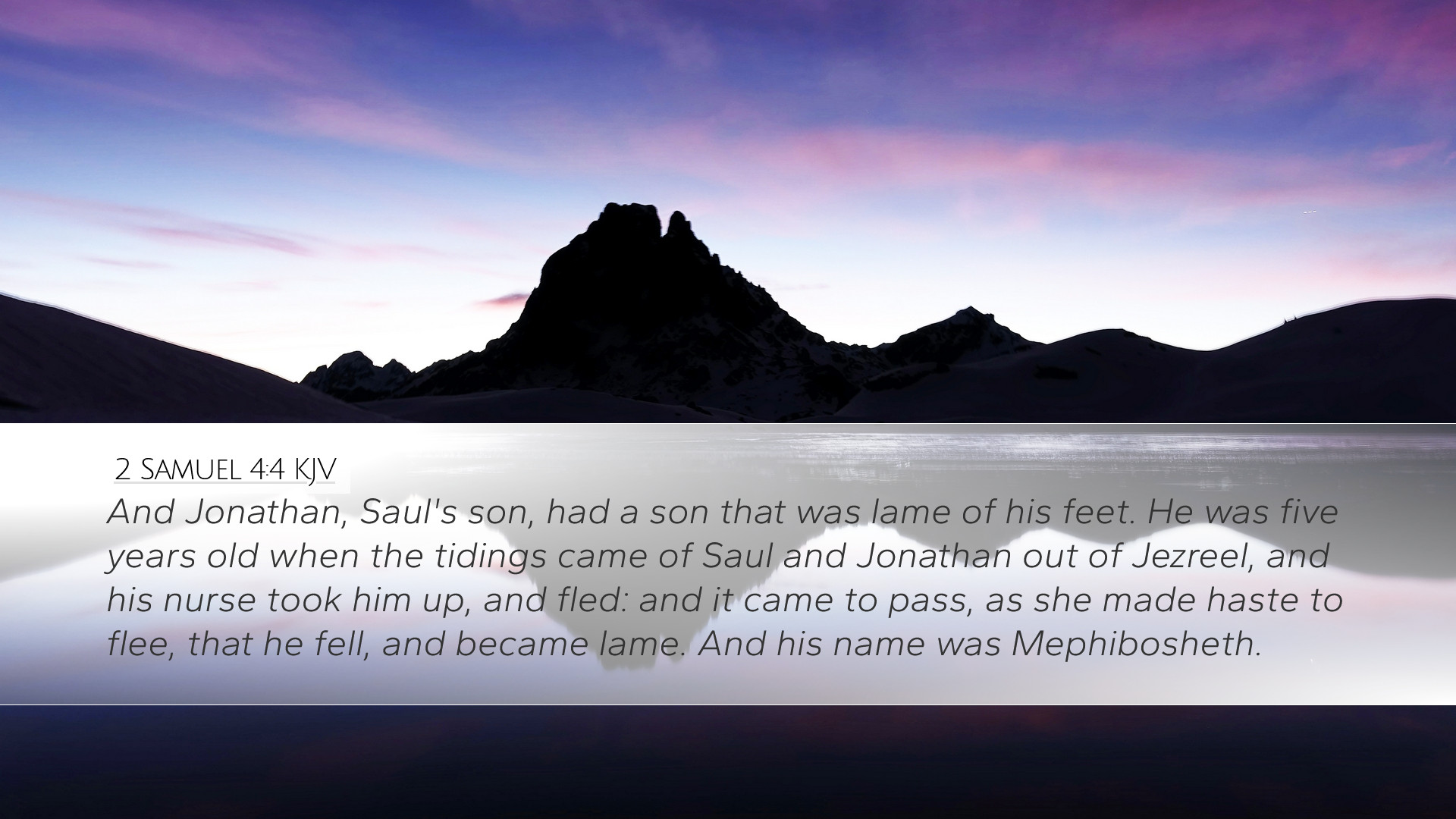Old Testament
Genesis Exodus Leviticus Numbers Deuteronomy Joshua Judges Ruth 1 Samuel 2 Samuel 1 Kings 2 Kings 1 Chronicles 2 Chronicles Ezra Nehemiah Esther Job Psalms Proverbs Ecclesiastes Song of Solomon Isaiah Jeremiah Lamentations Ezekiel Daniel Hosea Joel Amos Obadiah Jonah Micah Nahum Habakkuk Zephaniah Haggai Zechariah Malachi2 Samuel 4:4
2 Samuel 4:4 KJV
And Jonathan, Saul's son, had a son that was lame of his feet. He was five years old when the tidings came of Saul and Jonathan out of Jezreel, and his nurse took him up, and fled: and it came to pass, as she made haste to flee, that he fell, and became lame. And his name was Mephibosheth.
2 Samuel 4:4 Bible Commentary
Commentary on 2 Samuel 4:4
Verse: “And Jonathan, Saul's son, had a son that was lame of his feet. He was five years old when the tidings came of Saul and Jonathan out of Jezreel; and his nurse took him up, and fled: and it came to pass, as she made haste to flee, that he fell, and became lame. And his name was Mephibosheth.”
Introduction
This verse introduces Mephibosheth, the son of Jonathan, whose affliction serves as a poignant backdrop to the narrative of David’s rise and the complexities of royal lineage. This commentary draws insights from historical exegesis, psychological implications, and theological reflections provided by respected public domain commentaries.
Contextual Background
The backdrop of 2 Samuel 4:4 is essential for understanding the significance of Mephibosheth’s condition. The passage comes amidst the turmoil following the deaths of Saul and Jonathan, as David consolidates his power in Israel. Furthermore, the act of the nurse fleeing with Mephibosheth illustrates the pervasive fear and instability during this period.
Historical and Cultural Context
Matthew Henry underscores the dangers faced by the royalty following the demise of their predecessors. In ancient Israel, the fall of a dynasty often resulted in the extermination of the family members of the fallen king to eliminate any claim to the throne. Thus, Mephibosheth's injury is emblematic of the tragic fate of many in the royal line: a mixture of vulnerability and the fear of impending violence.
Spiritual and Theological Reflections
Albert Barnes highlights the theological lesson behind this narrative: the providence of God works through human actions, even in times of distress and chaos. The injury of Mephibosheth can be viewed as a metaphor for the fallen state of humanity, where pain and disability are parts of the human experience.
Character Analysis
Mephibosheth’s character provides insights into themes of grace and restoration. He is not merely a figure of misfortune but represents hope amidst despair.
The Nature of Mephibosheth’s Handicap
Adam Clarke elaborates on the physical and spiritual implications of Mephibosheth being lame. His lameness can symbolize the shortcomings and failures inherent in mankind. Just as Mephibosheth was physically disabled, so too is humanity spiritually handicapped without the grace of God.
The Role of the Nurse
The nurse’s hurried flight signifies the volatility of the political landscape. Her actions, although well-intentioned, led to Mephibosheth’s disability, raising questions about the consequences of fear-driven decisions. Matthew Henry notes that this act reflects the failures of those who ought to protect the vulnerable. It challenges pastors and theologians to consider how they respond to crises and protect those in their care.
Thematic Elements
The story of Mephibosheth intersects various themes prevalent throughout Scripture, such as grace, redemption, and the notion of the 'forgotten' or the 'outcast.'
Grace and Restoration
Throughout the Bible, those who are marginalized often encounter profound acts of grace. Mephibosheth’s story culminates in David's kindness extended to him later in 2 Samuel. Barnes indicates that Mephibosheth foreshadows God's work in reconciling the outcast to Himself, making this narrative vital for understanding God’s redemptive plan.
The Weight of Disability
Mephibosheth's lameness can also serve as a theological metaphor. It embodies the struggle of grace and the acknowledgment of human inability. In this way, Adam Clarke emphasizes that humanity’s spiritual lameness needs divine intervention for restoration. This theme resonates deeply with believers, reminding them of their need for God’s grace in every aspect of life.
Practical Applications
This verse prompts several applications for today’s believers and scholars:
- Understanding Disability: As we encounter individuals with disabilities or challenges in our communities, Mephibosheth’s story encourages compassion and understanding.
- Responding to Crisis: Like the nurse, our responses in fear can lead to unintended consequences. This narrative invites leaders to reflect on how decisions are made in crises.
- Emphasizing Grace: Pastors should leverage this story to teach about grace—how it meets us in our broken states and restores us to wholeness.
Conclusion
2 Samuel 4:4 may appear to be a mere historical note, but it encapsulates profound theological insights relevant for all believers. Mephibosheth’s narrative reminds us of the complexities of human experience amid divine grace. The shadows of legacy, fear, and spiritual need converge in this passage, compelling us toward a deeper understanding of God's work in our lives.


